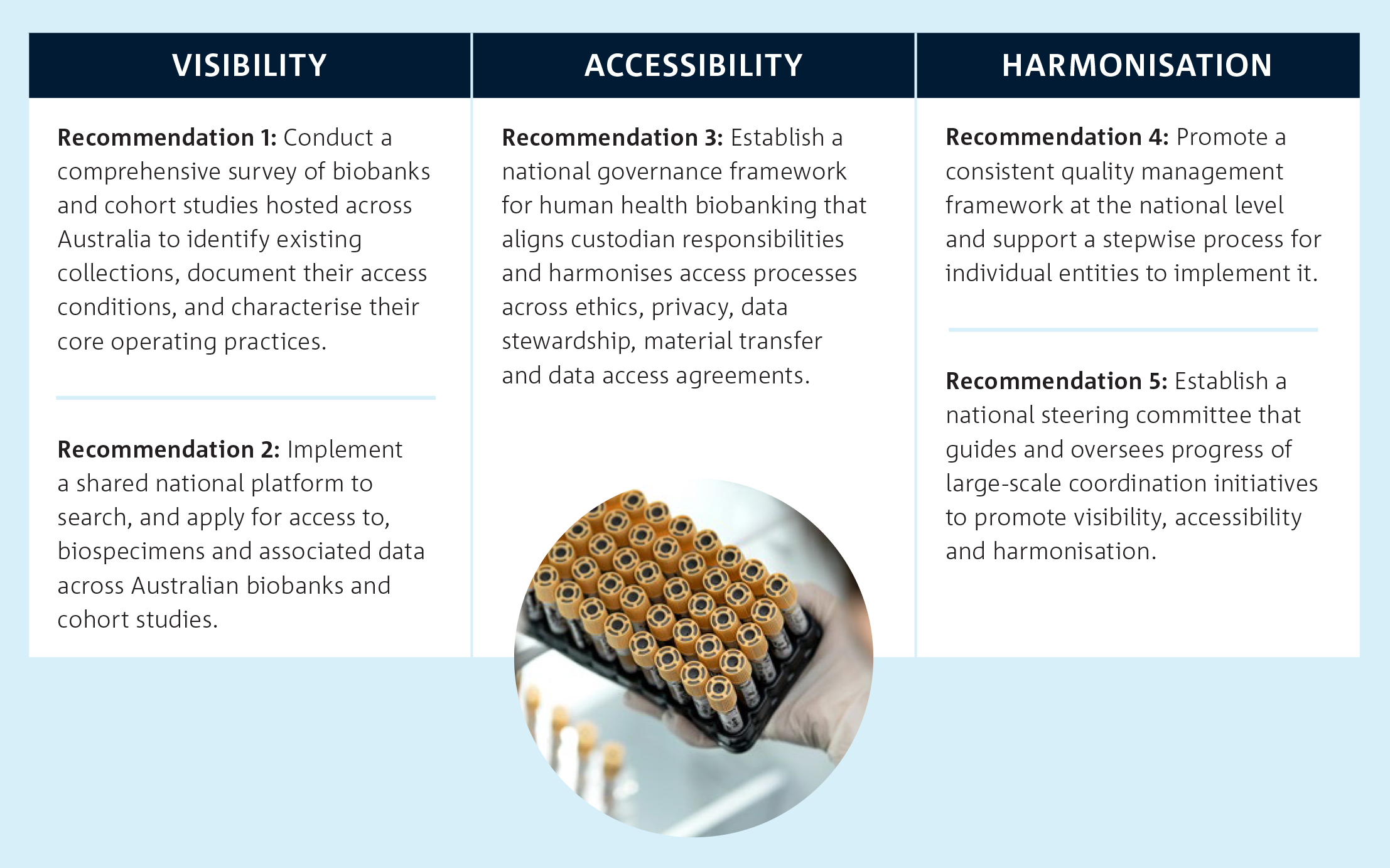Download the report
Benefits of national coordination and recommendations to achieve it
 CSIRO has led a project investigating increased coordination across Australian biobanks and cohort studies.
CSIRO has led a project investigating increased coordination across Australian biobanks and cohort studies.
The Valuation of increased coordination in Australian biobanking report estimates the direct financial benefits of a national platform for searching and accessing biospecimens and data at $39 million annually, and discusses visibility, accessibility, and harmonisation as forms of coordination needed in Australia.
Download the report
This report also provides five recommendations designed to address prevailing challenges, progress the three forms of coordination, and embed and sustain biobanks and cohort studies in the national research infrastructure ecosystem:

Why human health biobanking?
Human health biobanks drive improved health outcomes by housing and providing access to human biological materials and associated data that support biomedical, clinical and population health research. These collections are the key research infrastructure needed to maximise the impact of existing biospecimens and data, ensure that biological models represent the diversity of Australia’s population, and support government decision-making.
Why Australia?
In Australia, the total number of human health biobanks is unknown. However, there are at least 200 that collectively host and provide access to millions of biospecimens and associated data, most having emerged as local, de-centralised entities with varying levels of funding and on-going support. Absence of coordination at a national level has resulted in reduced visibility and traceability of individual collections, possible duplication of pre-existing collections, growth of biospecimen stocks without consideration of long-term demand, and inconsistent operating processes, data management systems and governance models. These challenges impact the financial and operational sustainability of biobanks and limit their accessibility to Australian and international R&D.
Why now?
Coordination of biobanks and cohort studies at a national level can offer a range of benefits to Australia's health research ecosystem. This includes reducing the time required to search and access biospecimens or data; ensuring inter-operability between national and international collections; supporting robust linkage with health data; guiding the establishment, expansion or retirement of collections; and improving overall risk management. These benefits advance the goal of enabling research and translation to improve health outcomes for the Australian population and are key to promoting international collaborations with academic and industry organisations.
Download the report
Benefits of national coordination and recommendations to achieve it
CSIRO has led a project investigating increased coordination across Australian biobanks and cohort studies.
The Valuation of increased coordination in Australian biobanking report estimates the direct financial benefits of a national platform for searching and accessing biospecimens and data at $39 million annually, and discusses visibility, accessibility, and harmonisation as forms of coordination needed in Australia.
Download the report
This report also provides five recommendations designed to address prevailing challenges, progress the three forms of coordination, and embed and sustain biobanks and cohort studies in the national research infrastructure ecosystem:
The report provides five key recommendations aimed at improving national coordination of biobanks and cohort studies:
Why human health biobanking?
Human health biobanks drive improved health outcomes by housing and providing access to human biological materials and associated data that support biomedical, clinical and population health research. These collections are the key research infrastructure needed to maximise the impact of existing biospecimens and data, ensure that biological models represent the diversity of Australia’s population, and support government decision-making.
Why Australia?
In Australia, the total number of human health biobanks is unknown. However, there are at least 200 that collectively host and provide access to millions of biospecimens and associated data, most having emerged as local, de-centralised entities with varying levels of funding and on-going support. Absence of coordination at a national level has resulted in reduced visibility and traceability of individual collections, possible duplication of pre-existing collections, growth of biospecimen stocks without consideration of long-term demand, and inconsistent operating processes, data management systems and governance models. These challenges impact the financial and operational sustainability of biobanks and limit their accessibility to Australian and international R&D.
Why now?
Coordination of biobanks and cohort studies at a national level can offer a range of benefits to Australia's health research ecosystem. This includes reducing the time required to search and access biospecimens or data; ensuring inter-operability between national and international collections; supporting robust linkage with health data; guiding the establishment, expansion or retirement of collections; and improving overall risk management. These benefits advance the goal of enabling research and translation to improve health outcomes for the Australian population and are key to promoting international collaborations with academic and industry organisations.
